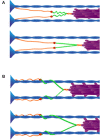Physiological Mechanisms of Eccentric Contraction and Its Applications: A Role for the Giant Titin Protein
- PMID: 28232805
- PMCID: PMC5299520
- DOI: 10.3389/fphys.2017.00070
Physiological Mechanisms of Eccentric Contraction and Its Applications: A Role for the Giant Titin Protein
Abstract
When active muscles are stretched, our understanding of muscle function is stretched as well. Our understanding of the molecular mechanisms of concentric contraction has advanced considerably since the advent of the sliding filament theory, whereas mechanisms for increased force production during eccentric contraction are only now becoming clearer. Eccentric contractions play an important role in everyday human movements, including mobility, stability, and muscle strength. Shortly after the sliding filament theory of muscle contraction was introduced, there was a reluctant recognition that muscle behaved as if it contained an "elastic" filament. Jean Hanson and Hugh Huxley referred to this structure as the "S-filament," though their concept gained little traction. This additional filament, the giant titin protein, was identified several decades later, and its roles in muscle contraction are still being discovered. Recent research has demonstrated that, like activation of thin filaments by calcium, titin is also activated in muscle sarcomeres by mechanisms only now being elucidated. The mdm mutation in mice appears to prevent activation of titin, and is a promising model system for investigating mechanisms of titin activation. Titin stiffness appears to increase with muscle force production, providing a mechanism that explains two fundamental properties of eccentric contractions: their high force and low energetic cost. The high force and low energy cost of eccentric contractions makes them particularly well suited for athletic training and rehabilitation. Eccentric exercise is commonly prescribed for treatment of a variety of conditions including sarcopenia, osteoporosis, and tendinosis. Use of eccentric exercise in rehabilitation and athletic training has exploded to include treatment for the elderly, as well as muscle and bone density maintenance for astronauts during long-term space travel. For exercise intolerance and many types of sports injuries, experimental evidence suggests that interventions involving eccentric exercise are demonstrably superior to conventional concentric interventions. Future work promises to advance our understanding of the molecular mechanisms that confer high force and low energy cost to eccentric contraction, as well as signaling mechanisms responsible for the beneficial effects of eccentric exercise in athletic training and rehabilitation.
Keywords: giant sarcomeric proteins; muscle atrophy; muscle intrinsic properties; space travel; sports injury rehabilitation; titin/connectin; winding filament hypothesis.
Figures





Similar articles
-
Re‑examining the mechanism of eccentric exercise‑induced skeletal muscle damage from the role of the third filament, titin (Review).Biomed Rep. 2023 Dec 1;20(1):14. doi: 10.3892/br.2023.1703. eCollection 2024 Jan. Biomed Rep. 2023. PMID: 38124762 Free PMC article. Review.
-
The role of titin in eccentric muscle contraction.J Exp Biol. 2014 Aug 15;217(Pt 16):2825-33. doi: 10.1242/jeb.099127. J Exp Biol. 2014. PMID: 25122914
-
Eccentric contraction: unraveling mechanisms of force enhancement and energy conservation.J Exp Biol. 2016 Jan;219(Pt 2):189-96. doi: 10.1242/jeb.124057. J Exp Biol. 2016. PMID: 26792330 Review.
-
Basic science and clinical use of eccentric contractions: History and uncertainties.J Sport Health Sci. 2018 Jul;7(3):265-274. doi: 10.1016/j.jshs.2018.06.002. Epub 2018 Jun 20. J Sport Health Sci. 2018. PMID: 30356648 Free PMC article. Review.
-
Titin force is enhanced in actively stretched skeletal muscle.J Exp Biol. 2014 Oct 15;217(Pt 20):3629-36. doi: 10.1242/jeb.105361. Epub 2014 Aug 21. J Exp Biol. 2014. PMID: 25147246
Cited by
-
Finite element human body models with active reflexive muscles suitable for sex based whiplash injury prediction.Front Bioeng Biotechnol. 2022 Sep 29;10:968939. doi: 10.3389/fbioe.2022.968939. eCollection 2022. Front Bioeng Biotechnol. 2022. PMID: 36246354 Free PMC article.
-
On the Shape of the Force-Velocity Relationship in Skeletal Muscles: The Linear, the Hyperbolic, and the Double-Hyperbolic.Front Physiol. 2019 Jun 19;10:769. doi: 10.3389/fphys.2019.00769. eCollection 2019. Front Physiol. 2019. PMID: 31275173 Free PMC article. Review.
-
N2A Titin: Signaling Hub and Mechanical Switch in Skeletal Muscle.Int J Mol Sci. 2020 Jun 1;21(11):3974. doi: 10.3390/ijms21113974. Int J Mol Sci. 2020. PMID: 32492876 Free PMC article. Review.
-
Change of Direction Speed: Toward a Strength Training Approach with Accentuated Eccentric Muscle Actions.Sports Med. 2018 Aug;48(8):1773-1779. doi: 10.1007/s40279-018-0907-3. Sports Med. 2018. PMID: 29594958
-
Evidence of a tunable biological spring: elastic energy storage in aponeuroses varies with transverse strain in vivo.Proc Biol Sci. 2019 Apr 10;286(1900):20182764. doi: 10.1098/rspb.2018.2764. Proc Biol Sci. 2019. PMID: 30966986 Free PMC article.
References
-
- Alfredson H., Pietilä T., Jonsson P., Lorentzon R. (1998). Heavy-load eccentric calf muscle training for the treatment of chronic Achilles tendinosis. Am. J. Sports Med. 26, 360–366. - PubMed
Publication types
LinkOut - more resources
Full Text Sources
Other Literature Sources

